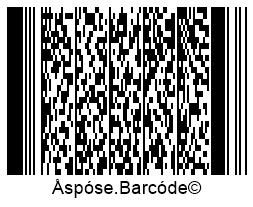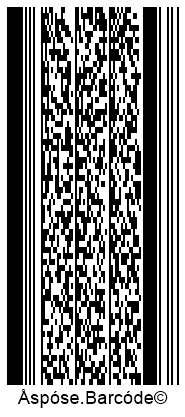Generate PDF417 Barcodes in C++
Overview
PDF417 is a group of 2D variable-length stacked symbologies that are similar to matrix barcodes in terms of various parameters. This standard supports laser scanning for high-quality documents (except Compact PDF417 that requires photo scanning). PDF417 barcodes have data density that is lower than that of matrix symbologies but several times greater compared to basic 1D stacked barcode types. PDF417 standards enable encoding both byte streams and Unicode symbols. Moreover, PDF417 barcodes include additional information for data recovery through Reed-Solomon error correction.
The other peculiarity of the PDF417 barcode family is the extended format of representing metadata so that one file can be divided into several barcodes and then transmitted on a printed document indicating file date, name, checksum, and other information. However, metadata require additional space in a barcode image. The layout of PDF417 barcodes includes rows and columns. The basic PDF417 standard can encode up to 1,108 bytes or 1,850 alphanumeric (2,710 numerical) symbols in up to 30 columns and 90 rows while Micro PDF417 is capable of encoding at most 150 bytes of data or 266 alphanumeric (366 numerical) characters in up to 4 columns and 44 rows.
PDF417 Standard |
Description |
|---|---|
| Basic PDF417 | Basic PDF417 that is intended for work with documents of any quality and provides the possibility of laser scanning |
| Micro PDF417 | Specialized PDF417 standard that allows saving print space and is intended for joint use with two-component barcodes based on GS1 composite symbologies or for work with high-quality documents |
| Macro PDF417 | PDF417 barcode type with the possibility to add metainformation |
| Compact PDF417 | PDF417 standard that can be with or without metainformation and is intended to address space limitations; in such barcodes, the right-side block of metadata is omitted, and the stop pattern is removed. This barcode type does not support laser scanning (only photo scanning can be used) and requires high-quality documents for successful recognition |
PDF417 and Macro PDF417
PDF417 and Macro PDF417 barcodes may contain from 1 to 30 columns with input data, 2 columns with auxiliary metainformation (such as row indicator, the number of rows and columns) and then, start and stop patterns. The number of rows can vary from 3 to 90. The main distinction between Macro PDF417 and Basic PDF417 is the possibility to encode additional metadata about barcode contents. This redundancy associated with auxiliary metadata allows reading such barcodes using laser scanners as well as reducing barcode image quality requirements. The specificities of using Macro PDF417 in Aspose.BarCode for C++ are discussed further in the corresponding subsection.

Micro PDF417
Micro PDF417 can include from 1 to 4 columns and from 4 to 44 rows; the maximal and minimal numbers of rows depend on the number of columns according to the predefined combinations of rows, columns, and error correction codewords. In addition, each barcode contains two columns with metadata that serve as targets for barcode location in an image. In general, Micro PDF417 is used for work with high-quality documents due to barcode recognition difficulties; at the same time, these barcodes can be read by laser scanners.

Compact PDF417
The specification of Compact PDF417 is similar to those of Basic PDF417 and Macro PDF417; however, the right-side metainformation column and the right-side stop pattern are removed to save space for small-sized barcodes. This symbology does not support laser scanning; moreover, due to the absence of metainformation redundancy, it has difficulties with low-quality barcode image recognition. To set the Compact PDF417 generation mode in Aspose.BarCode for C++, it is necessary to initialize the Pdf417Truncate property of class Pdf417Parameters.

PDF417 Data Encoding Modes
To select the data encoding mode in Aspose.BarCode for C++, it is required to set the Pdf417CompactionMode property of class Pdf417Parameters that specifies data compaction regimes to be used during barcode generation. To encode Unicode symbols, two other properties, Pdf417ECIEncoding and CodeTextEncoding, can be used. Detailed explanations and code samples for these properties are provided further in the article.
ECI Encoding Mode
Besides encoding Unicode characters into byte streams, the Pdf417ECIEncoding property allows setting the ECI identifier for the current encoding that can be read and correctly interpreted by decoders. In the case of setting this property using any value that differs from ECIEncodings.NONE, data processing is performed using the specified ECI encoding. The present library implementation includes all well-known charset encodings that are listed in the ECIEncodings enumeration.

Compaction Mode
As mentioned above, to select the required data compaction way, the Pdf417CompactionMode property needs to be initialized using one of the supported compaction modes are described below.
| Compaction Mode | Description |
|---|---|
| Auto | Encoding is performed in the most high-density data compaction mode that is selected automatically. In the case when CodeText contents include a digit greater than 255, data compaction is executed using the encoding specified in CodeTextEncoding |
| Binary | This mode is intended to encode binary byte streams with digits from 0 to 255. If CodeText contains a digit greater than 255, data compaction is performed using the encoding set in CodeTextEncoding |
| Text | Legacy mode to encode alphanumeric data. It is recommended to use the Auto mode |
| Numeric | Legacy mode to encode numerical digits. It is recommended to use the Auto mode |
Barcode images demonstrated below have been generated using different compaction mode settings.
| Compaction Mode | Auto | Binary | Text | Numeric |
|---|---|---|---|---|
 |
 |
 |
 |
Unicode Encoding Mode
The CodeTextEncoding property can be used to encode Unicode characters in the Binary mode.

Byte Stream Encoding in Binary Mode
When it is needed to encode and transmit an array of bytes in a barcode, developers can use the Binary mode that can be set in Aspose.BarCode for C++ using the Pdf417CompactionMode property of class Pdf417Parameters. To display the custom text under a barcode, the TwoDDisplayText property needs to be set.

Barcode Layout Settings
To set the number of rows and columns in PDF417 barcodes, Aspose.BarCode for C++ enables the corresponding properties of class Pdf417Parameters that are called Rows and Columns. Basic PDF417, Macro PDF417, and Micro PDF417 standards allow arbitrarily set the number of columns from 1 to 30 and the number of rows from 3 to 90. The number of rows and columns can be set independently. In turn, Micro PDF417 supports setting from 1 to 4 columns so that the maximal and minimal numbers of rows depend on the number of columns. In case if the barcode type capacity is insufficient to generate a barcode with the requested number of rows and columns, an exception will be thrown.
PDF417 barcode images provided below have been generated using different layout settings.
| Layout Settings | 2 Columns | 6 Rows | 9 Rows and 6 Columns |
|---|---|---|---|
 |
 |
 |
Error Correction Level Settings
The PDF417 barcode family applies the Reed-Solomon error correction mechanism to perform data recovery and integrity check. In Micro PDF417 barcodes, the amount of redundant recovery information is defined automatically. To set the error correction level for Basic PDF417, Macro PDF417, and Compact PDF417 in Aspose.BarCode for C++, developers can use the Pdf417ErrorLevel property of class Pdf417Parameters. Adding each two error correction (EC) codewords allows recovering one unknown error or two known character removals. The higher is the EC level, the larger is the number of EC codewords in a barcode and accordingly, the better is the result of data recovery for severely damaged barcode images. The maximal Level8 implies that 265 errors can be corrected; at the same time, the barcode encoding capacity will be reduced by 614 bytes. All supported EC levels are listed below.
| EC Level | Number of EC Codewords | Error Correction Level | Number of EC Codewords |
|---|---|---|---|
| Level 0 | 2 EC codewords | Level 5 | 64 EC codewords |
| Level 1 | 4 EC codewords | Level 6 | 128 EC codewords |
| Level 2 | 8 EC codewords | Level 7 | 256 EC codewords |
| Level 3 | 16 EC codewords | Level 8 | 512 EC codewords |
| Level 4 | 32 EC codewords |
PDF417 barcode images shown below have been created using different error correction level settings.
| Error Correction Level | Is Set to 2 | Is Set to 5 |
|---|---|---|
 |
 |
Aspect Ratio Settings
Aspect Ratio is defined as the ratio between the barcode width and height. In Aspose.BarCode for C++, to customize barcode proportions using the X and Y coordinates, the AspectRatio property of class Pdf417Parameters can be used. It is implemented as a relative coefficient to the value of the XDimension parameter. For PDF417 barcodes, the value of AspectRatio should be set between 3 and 5.
PDF417 barcodes demonstrated below have been created using different aspect ratio settings.
| Aspect Ratio | Is Set to 2 | Is Set to 5 |
|---|---|---|
 |
 |
PDF417 Metadata Encoding
Macro PDF417 and Micro PDF417 standards enable encoding additional metainformation about data origins and identification. These metadata are encoded in barcodes along with main input information and occupy the same data blocks. Metadata can be classified into permanent and optional ones that are explained further.
Permanent Metadata Settings
Permanent metadata that determine encoding the rest of the fields include the following parameters.
| Permanent Metadata Field | Description |
|---|---|
| Pdf417MacroFileID | Unique identifier of a barcode series or PDF417 file that is set manually |
| Pdf417MacroSegmentID | Current segment identifier that starts with 0 and often is accompanied with an optional field called Pdf417MacroSegmentsCount that specifies the number of barcodes in a series |

Optional Metadata Settings
Optional metadata include various fields that are listed in the table below.
| Optional Metadata Field | Description |
|---|---|
| Pdf417MacroSegmentsCount | Number of barcodes in a series |
| Pdf417MacroFileName | Name of a file |
| Pdf417MacroChecksum | Checksum of a file that is calculated using CCITT-16 polynomial |
| Pdf417MacroFileSize | Total size of bytes in a series |
| Pdf417MacroTimeStamp | Time of creating/sending the file |
| Pdf417MacroAddressee | Address of the file sender |
| Pdf417MacroSender | Name of the file sender |

Unicode Metadata Settings
If required, it is possible to transmit optional metadata fields in the Unicode encoding by initializing the Pdf417MacroECIEncoding property that converts the data and sends it together with the corresponding encoding identifier.

PDF417 Special Parameters
For the PDF417 barcode family, Aspose.BarCode for C++ allows encoding special control parameters, such as indicating hardware reader initialization and Code 128 emulation.
Hardware Reader Initialization
To encode the special flag indicating that the barcode data is intended for hardware reader initialization, developers can use the IsReaderInitialization property.

Code 128 Emulation
To indicate that hardware readers must emulate the considered Micro PDF417 barcode as the data read from a Code 128 barcode, the Code128Emulation field needs to be initialized.
